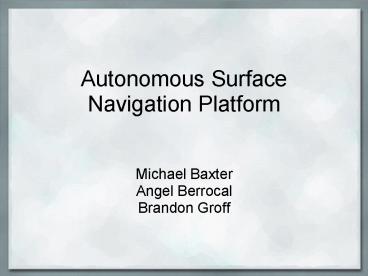Autonomous Surface Navigation Platform PowerPoint PPT Presentation
1 / 21
Title: Autonomous Surface Navigation Platform
1
Autonomous Surface Navigation Platform
- Michael Baxter
- Angel Berrocal
- Brandon Groff
2
Project Overview
- General platform capable of autonomous navigation
and adaptable to land and sea surface
environments. - Apply sensor technology for a basic navigation
software foundation on which to build more
complex autonomous algorithms for homeland
security. Primary client is multiple branches of
the US Military. - Estimate development costs at 41,000 initial
cost of a prototype system, including
instrumentation and wiring, should be less than
10,000.
3
Technical Objectives
- Basic Autonomous Navigation
- Collision Avoidance
- Path Planning and Following
- Propulsion System Control
- Recognition of Objective
- Object Color Shape Recognition
- Built Using LabVIEW CompactRIO Platforms
- Readily available
- LabVIEW Vision Module is easier to use than other
solutions
4
Demonstration of Objectives
5
Navigation System Design
6
Actual Design Implementation
7
Overall Program Flow
8
Path Planning
- Requirements
- Enable vehicle to drive toward target object by
determining direction in which it should proceed - Requires a devices to determine the current
position and angle of the robot. - GPS Device - Determination of absolute position
- Inertial Motion Unit (IMU) - Information about
robot yaw - Software Interface Requirements
- LabVIEW 2009
- CompactRIO Serial Module for GPS Interface
- Caveats
- GPS Module has accuracy of 3 meters or less
using Wide Area Augmentation System (WAAS)
9
Path Planning Algorithm
10
Path Following
- Requirements
- Must allow robot to follow a planned path
- May initiate object avoidance while following
path - Needs sensors to track current heading, and watch
for potential obstacles - IMU - Track heading can be reused from Path
Planning - Vex Sonar - obstacle detection avoidance
- Trade offs
- Shaft Encoder - Less expensive, require more
programming, propulsion-system dependent
11
Path Following Algorithm
12
Collision Avoidance
- Requirements
- Autonomous navigation without collisions which
may stop, damage or otherwise hinder the
vehicle's movement - Requires sensor for detection of distances to
objects - Laser Range Finders - very expensive
- Vex Ultrasonic Sonar - very cheap and available
- Software Requirements
- LabVIEW 2009
- LabVIEW FPGA Module (sonar interface)
- Caveats
- Cheaper sensors require better software
13
Collision Avoidance Algorithm
14
Object Search Recognition
- Requirements
- 360-degree view to scan for possible object color
and shape recognition - One camera facing forward and one facing backward
for improved search time - Requires two cameras that are compatible
with micro-controller CompactRIO - Axis M1011 Ethernet cameras can be used
simultaneously with CompactRIO - Wireless-G Linksys Router 2.4 GHz
- Software Requirements
- LabVIEW 2009 LabVIEW Vision Development Module
- Caveats
- Better cameras with higher resolution are costly
- Low resolution requires better image processing
15
Object Search
16
Object Recognition Algorithm
- LabVIEW Vision Module allows high-level
development of vision algorithms in a
block-diagram fashion
- LabVIEW Vision Assistant Block Diagram
17
Propulsion System Control
- Requirements
- Must be able to control Thrusters for marine
vehicles as well as Vex motors for land
demonstration - Both use 1-2 ms Pulse-Width Modulation signals
- Requires hardware interface between LabVIEW and
propulsion system - CompactRIO Digital I/O Module
- Software Requirements
- LabVIEW 2009
- LabVIEW FPGA Module
18
Schedule of Future Work
19
Design Issues
- GPS Device
- Payment issues purchasing first GPS CompactRIO
module - Received a pledge for a donated GPS CompactRIO
module from Marine Innovations, however their
driver appeared to be for an old version of
LabVIEW - Package from Marine Innovations showed up empty
- Just purchased a Garmin stand-alone unit with
serial interface - Vex sonar inaccuracies
- Sonars are relatively cheap and often provide
inaccurate readings - requires averaging and
filtering of data
20
Summary of current status of project
- Vehicle Status
- Test platform assembled
- Motors, Cameras, Router, IMU, Sonars, and cRIO
mounted - Garmin GPS has not arrived, driver available from
National Instruments - Power Plan designed - 24V 7.2V batteries with 2
DC-DC converters - Algorithm Status
- Able to gather usable data from sonars, cameras,
and IMU - Object recognition algorithm successfully
differentiates between similar objects indoors
and determines distance to object - Successful propulsion system control with cRIO
21
LabVIEW Test Program Example

